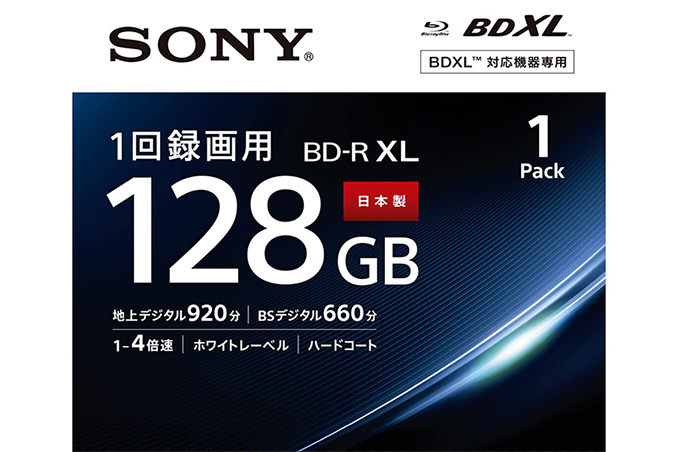Sony Releases Quad-Layer 128 GB BD-R XL Media
by Anton Shilov on November 9, 2018 1:00 PM EST
Sony is about to start selling the industry’s first 128 GB write-once BD-R XL optical media. The discs will also be the first quad-layer BDXL media formally aimed at consumers, but bringing benefits to professionals that use BDXL today.
Although the general BDXL specifications were announced back in 2010 for multi-layered write-once discs with 25 GB and 33.4 GB layers, only triple-layer BDXL discs with a 100 GB capacity (generally aimed at broadcasting, medical, and document imaging industries) have been made available so far. By contrast, quad-layer 128 GB media has never seen the light of day until now.
As it turns out, increasing the per-layer capacity of Blu-ray discs (BDs) to 33.4 GB via a technology called MLSE (Maximum Likelihood Sequence Estimation) was not a big problem, and most of today’s BD players and optical drives support the BDXL standard. However, increasing the layer count to four while ensuring a broad compatibility, signal quality across four layers, yields, and some other factors slow downed release of 128 GB BDXL essentially by eight years.
In a bid to build a viable quad-layer 128 GB write-once BDXL disc, Sony had to design three new materials. First, the company had to create a new recording alloy that would provide the right combination of reflectance and transmittance to ensure that the layers can “reflect” data bits when needed while allowing the 405nm laser to pass through them when another layer is accessed. Then, Sony had to develop a new inter-layer material (called dielectric) that would also be able to transmit light waves. Finally, because with four layers the first one has to be located closer to the disc’s surface, Sony had to design a new protective coating for the media.
Sony will start shipments of its BD-R XL 128 GB media on the 10th of November. Single-disc packages (BNR4VAPJ4) will retail for ¥1,500 ($13), a pack of three (3BNR4VAPS4) will cost ¥3,900 ($34), whereas a pack of five (5BNR4VAPS4) will be priced at ¥6,000 ($53). The discs should be compatible with drives supporting the BDXL spec, though a firmware update may be needed regardless.
Related Reading:










44 Comments
View All Comments
xiaohongshu - Sunday, May 1, 2022 - link
Nice post😎👍xiaohongshu - Sunday, May 1, 2022 - link
Nice post😎👍Samus - Monday, November 12, 2018 - link
Flash\NAND memory has decent retention if kept in ideal environmental conditions (low humidity, temperature, and light)But modern NAND is becoming pretty bad with retention. TLC\QLC are rated in single-digit years for shelf-life. Optical media is rated in double, and even triple digit years for shelf-life.
p1esk - Friday, November 9, 2018 - link
I wonder if it's suitable for distributing future 8k movies.Lolimaster - Friday, November 9, 2018 - link
Optical media is dead till they bump again the capacity to 100-150GB per layer and each disk at $3-5.nandnandnand - Saturday, November 10, 2018 - link
This weaksauce disc would have been impressive over a decade ago. Now we could use holographic media capable of storing petabytes.CiccioB - Saturday, November 10, 2018 - link
Depends on what you use for. I can't see flash thumb drives with 128GB capacity going away for $10, which would be the right price if an optical disk of the same capacity would cost $3.If you use optical media for backups of important data (Vs cheap storage for useless data retention) you would try to use the best media brands nonetheless, and spending $15 for 100GB for reliable capacity is not that much.
BTW, for cheap useless data storage, some single layer BR already are about $5 for a pack of 6 = about 150GB
CheapSushi - Friday, November 9, 2018 - link
This is awesome. I'm glad there is still development on this front. I know it doesn't pertain to most. But I started using optical discs for my homelab for archiving certain data as an alternative to tapes.13Gigatons - Saturday, November 10, 2018 - link
I used to love BluRay, it feels so dated now. That kind of scares me. I wonder what else falls by the wayside.StrangerGuy - Saturday, November 10, 2018 - link
128GB BD-R at $13 (10GB/$ not including the burner, works on like 0.001% of PCs, I'm sure rural grandma without Internet is part of that 0.001% amirite?)--versus--
4TB ext HDD at $100 (40GB/$, works on every PC in existence)
Wow, totally seeing mass BD-R adoption right there. *snicker*